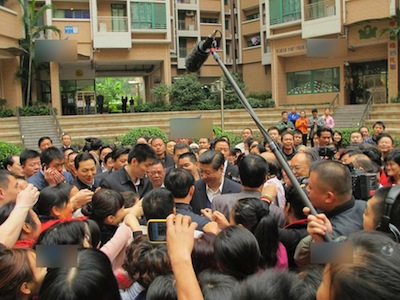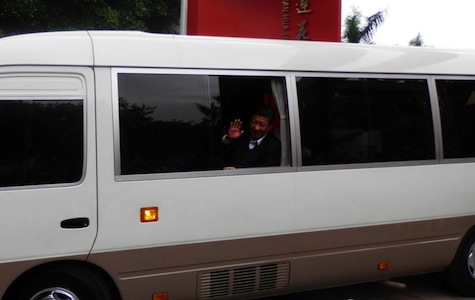
Xi surrounded by the public

Xi in a car waving to the public
China’s new president, Xi Jinping, paid a visit to Shenzhen, China’s most burgeoning Southern city in Guangdong province over the weekend. This was no small tour. Xi was literally stepping in Deng Xiaoping’s footprints twenty years ago, when/where Deng delivered one of his most important speeches, three years after Tian’anmen, in which he reassured China’s course to a marketing economy and its deeper integration into the global economy. New to the most powerful position in China (and some might argue the second most powerful position globally), Xi was quick to take advantage of the 20th anniversary of Deng’s speech in Southern China and acted like the incarnation of Deng in 1992. He was even accompanied by four of the former officials who accompanies Deng during Deng’s tour when he visited Deng’s memorial in Shenzhen.
Like Deng, Xi reassured China’s reform and opening up policy. “The Party and the Central government have made the correct decision of reform and opening up,” Xi said on this tour, “in the future we will still take this correct way; we will go in this way to an affluent country and an affluent people with conviction and determination, and we will have innovation.”
However, besides the speech, Chinese media have also focused their coverage on Xi’s image as an approachable and low-key leader who cares about ordinary people’s lives. Headlines about Xi’s Tour read like “Xi Jinping Touring Shenzhen, No Roads Blocked for Security,” “Visiting Families in Poverty in Shuide City, Giving Children English Dictionary,” “Visiting Residents in Luohu Fishing Village, Encouraging Villagers to Continue Walking on Deng Xiaoping’s Way,” “Visiting Shenzhen, No Welcoming Parade, No Banners,” and “Opened Window and Waved Goodbye to the Public, Shenzhen Netizen Meeting President.” Xi’s photos surrounded by the public are posted on news websites, and accounts about “foreign media’s” positive opinions about Xi. There also Xi’s family photos published, which is very rare in Chinese media.
Efforts to create a personable image for Chinese top leaders have been rare. Xi may showcase a shift in how Chinese approach politics as the public has been gaining more power–if not substantial, at least in speech–in China’s politics. This could be a positive shift, but at the same time, the image-oriented way of doing politics as most well represented in the U.S. is perhaps not the best option to promote democracy either. The worst, though, will be a marriage between sophisticated image management and highly centralized power structure. For now, it seems that Chinese and the Western media are enjoying a rare common ground that sees Xi representing a possibly more liberal future of China.
